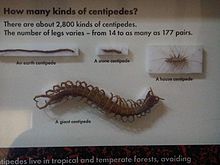Pachymerium ferrugineum
Pachymerium ferrugineum is a species of centipede in the family Geophilidae that can be found in Central Europe, the Iberian Peninsula, Scandinavia, Asian countries such as Japan and Turkey, and on African islands such as the Azores, Canary Islands and Crete. It is also distributed in Alaska and Mexico.[1]
| Pachymerium ferrugineum | |
|---|---|
 | |
| English: Up, from left to right: Earth centipede, Stone centipede, House centipede and down Peruvian giant orange leg centipede. | |
| Scientific classification | |
| Kingdom: | |
| Phylum: | |
| Class: | |
| Order: | |
| Family: | |
| Genus: | |
| Species: | P. ferrugineum |
| Binomial name | |
| Pachymerium ferrugineum (C. L. Koch, 1835) | |
| Synonyms[1] | |
| |
Research
Various studies have been done on the intraspecific variation of Pachymerium ferrugineum to show the significance of the species geographical location to their number of leg-bearing segments. One study published in the Biological Journal of the Linnean Society showed that these species exhibit more leg-bearing segments in Southern geographical locations versus the Northern regions in North-west Europe.[2] A study conducted in the Aegean region has shown that the leg-bearing segments of Pachymerium ferrugineum in the Cyclades possibly vary due to insular characteristics of the island.[3]
Ecology
The species is terrestrial that can be found on White Sea seashore.[1]
References
- A. D. Barber (2013). Barber AD (ed.). "Pachymerium ferrugineum". World database of littoral Myriapoda. World Register of Marine Species. Retrieved June 23, 2013.
- Simaiakis, Stylianos (August 2010). "A study of the diversity and geographical variation in numbers of leg-bearing segments in centipedes (Chilopoda: Geophilomorpha) in north-western Europe". Biological Journal of the Linnean Society. 100 (4): 899–909. doi:10.1111/j.1095-8312.2010.01467.x.
- Simaiakis, Stylianos; Mylonas, Moysis (August 2004). "Intraspecific variation in segment number in Pachymerium ferrugineum (C.L. Koch, 1835) (Chilopoda: Geophilomorpha) in the south Aegean Archipelago (north-east Mediterranean, Greece)". Biological Journal of the Linnean Society. 88 (4): 533–539. doi:10.1111/j.1095-8312.2006.00635.x.
Further reading
- Iorio, E. (2005). "Contribution à la connaissance des chilopodes de Bretagne (Myriapoda, Chilopoda)". 140 (33). Bordeaux: Bull. Soc. Linn.: 149–156. Cite journal requires
|journal=(help) - Johns, P. M. (2009). "Myriapoda". Gordon, D. (Ed.) (2009). New Zealand Inventory of Biodiversity. 1: 584.
- Palmen, E. (1949). "The Chilopoda of Eastern Fennoscandia". 13 (4). Ann.Zool.Soc.Zool.Bot.Fenn. Vanamo: 1–45. Cite journal requires
|journal=(help) - Barber, A. D. (2009). "Littoral myriapods; a review". Soil Organisms. 81 (3): 735–760.